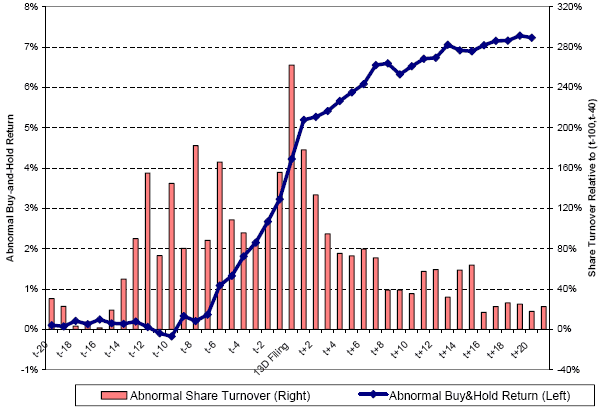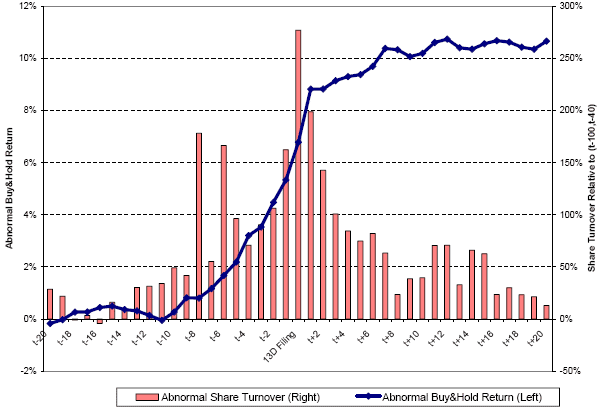When hedge funds publicly demand that management of firms in which the funds hold large stakes take steps to improve stock prices, should other investors take notice? Do such demands distract or focus management regarding shareholder interests? In the November 2006 draft of their paper entitled “Hedge Fund Activism, Corporate Governance, and Firm Performance”, Alon Brav, Wei Jiang, Frank Partnoy and Randall Thomas investigate the relationship between hedge fund activism and stock returns. They identify instances of fund activism by (1) searching 2001-2005 news databases for stories mentioning both “activism” and “hedge fund” and (2) analyzing associated SEC Schedule 13D filings, with special attention to the reasons for the transactions as stated in the filings. Using the resulting set of 888 events involving 131 funds and 775 companies, they conclude that:
- Activist hedge funds target profitable firms with: market capitalization in the lower 80%; high book-to-market value ratio; solid operating cash flow and return on assets; and, a dividend smaller than those of peer companies.
- About one quarter of activist events are hostile. It is common for multiple hedge funds to act in concert, either formally or informally.
- Stocks of targeted firms yield an average excess return of about 7.2% in an interval of a few weeks around Schedule 13D filing dates, with about 4% of this total after filings. (See the first chart below.) Activism based on specific objectives explicitly stated in the filings generates higher pre-filing excess returns than does a more general activism. (See the second chart below.) These short-term excess returns related to hedge fund activism do not typically reverse during the subsequent year.
- The most dramatic examples of activism, such as demands for sale of the company (10.9%), tend to generate the highest excess returns. Also, market reactions are stronger for small firms and firms with the lowest dividend payouts. In contrast, demands for changes in capital structure and governance generate on average no significant excess returns.
- Compared to untargeted peers, average return on equity and return on assets of targeted firms improve substantially over the year after Schedule 13D filings. Target firm leverage rises modestly. CEO pay declines, and CEO turnover increases.
- Activist hedge funds achieve their principal stated goals 41% of the time, with partial success another 26% of the time.
- Average excess returns decline steadily across the sample period from 10.6% in 2001 to 4.8% in 2005. Growth in the number and size of hedge funds may further dissipate excess returns.
The following chart, taken from the paper, shows the average cumulative excess return (relative to the broad market) for stocks targeted by activist hedge funds from 20 days before to 20 days after Schedule 13D filing dates for all events except the 108 M&A arbitrage cases. It also shows the change in share turnover as a percentage of an average pre-event turnover rate. The total average excess return around the Schedule 13D filing date is 7.2%, with 3.2% of the total occurring in the ten days before filing and 2% occurring on the filing date and the day after. Trading volumes are elevated throughout the share price advance. For the full sample, 64% events have positive excess returns.

The next chart, also from the paper, similarly shows the average cumulative excess return (relative to the broad market) for the 229 events in which hedge funds state a specific agenda in the Schedule 13D filings. For these events, the total average excess return around the Schedule 13D filing date is over 10%, with 5.3% occurring in the ten days before filing and 3.3% occurring on the filing date and the day after. Trading volumes are again elevated throughout the share price advance.

In summary, agile traders may be able to capture significant short-term gains in stocks targeted by hedge funds via large equity positions and aggressive, specific and public demands on management.